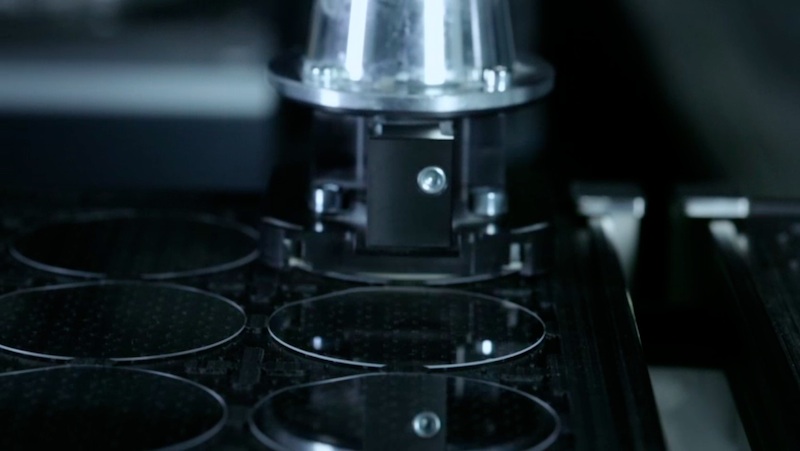While Apple remains coy about plans to incorporate sapphire into its product lineup, a new patent application published on Thursday suggests the company is at the least experimenting with the hard material for use in touch-capable displays.
Apple's "Oleophobic coating on sapphire" patent application represents some of the first hard evidence that the Cupertino, Calif. company is looking to include sapphire in its iPhone lineup.
Aside from the illustration of an iPhone on the filing's cover page, Apple's document makes repeated mention of sapphire displays in phones, tablets and other portable devices.
Specifically, the filing describes in detail the methods by which an oleophobic, or oil-repelling, coating can be applied to a sapphire slab prior to installation in a mobile device. Oleophobic coatings were first used by Apple with the iPhone 3GS in an attempt to counter the buildup of oil and other detritus inevitable with a touchscreen display.
Since then, iPhone and iPad models have all come with the repellent coating, though methods of application used for Gorilla Glass do not necessarily apply to a material like sapphire. For example, Apple points out that normal bonding techniques may not work with sapphire or sapphire glass because of its crystal structure.
The document also notes certain coatings and oleophobic treatments do not fair well when applied directly to sapphire glass. Abrasion tests have shown some coatings and treatments last for a "lower number of abrasive cycles when applied to sapphire glass and other alumina-based base layers (e.g., less than 300 cycles), as compared to silica glass, where the coatings may not exhibit wear until a higher number of abrasive cycles (e.g., 300 cycles or more)." Additionally, the same surface treatments applied to a silica substrate may exhibit wear at an even lower number of cycles when a transition layer is not present.
To address this issue, Apple proposes a transitional layer be disposed between the base substrate and the oleophobic coating. Further, a surface layer may be composed of alumina, silica or a combination of the two.
In one embodiment, the transitional layer consists of a combination of base layer materials and other components like alumina-silica glass, a form of which is marketed by Corning as Gorilla Glass. The layer is applied via a sputtering process, physical or vapor deposition (PVP or CVP), or other suitable method. The surface and oleophobic layers may likewise be applied using the same processes.
Apple notes the end result of this sapphire-transitional layer-surface layer sandwich is a largely continuous and uniform structure that retains the benefits of sapphire's hardness, while allowing for the operable application of an oleophobic coating.
It is unknown if Apple will use sapphire as a display material in its upcoming iPhone and iPad lineups, but the invention outlined in Thursday's filing overcomes a major hurdle standing in the way of mass consumption.
In November, Apple signed a $578 million deal with sapphire producer GT Advanced Technologies to supply the super hard material for an as-yet-unseen product component. Many analysts and insiders speculate the partnership, which birthed a dedicated sapphire plant in Arizona, will inevitably lead to sapphire displays.
Apple's oleophobic coatings for sapphire patent application was first filed for in September of 2013 and credits Douglas Weber and Naoto Matsuyuki as its inventors.
 Mikey Campbell
Mikey Campbell







-m.jpg)






 Marko Zivkovic
Marko Zivkovic
 Christine McKee
Christine McKee
 Andrew Orr
Andrew Orr
 Andrew O'Hara
Andrew O'Hara
 William Gallagher
William Gallagher

 Mike Wuerthele
Mike Wuerthele
 Bon Adamson
Bon Adamson



-m.jpg)



15 Comments
SO: iPhone 6 -> sapphire display iPhone 7 -> sapphire display with oleophobic coating iPhone 8 -> another kind of display iPhone 8 -> another kind of display with oleophobic coating ...
What does an 'abrasive cycle' mean? If something lasts for 300 'abrasive cycles', what does that mean for practical usage?
The lens surface of the iP 5 is hard to smudge. It already has a coating.
[quote name="enzos" url="/t/174228/apple-tips-hand-on-sapphire-displays-with-patent-for-oleophobic-coatings#post_2503345"]The lens surface of the iP 5 is hard to smudge. It already has a coating.[/quote] Yes it does, but it seems like the coating doesn’t play nice with sapphire.
Apple doesn't innovate.
/s